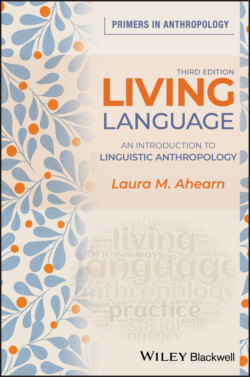Читать книгу Living Language - Laura M. Ahearn - Страница 48
Matched Guise Tests
ОглавлениеA researcher interested in language ideologies might conduct a matched guise test, a process that involves recording individuals as they read a short passage in two or more languages or dialects (“guises”). In other words, if four people are recorded, eight (or more) readings of the same passage might be produced. For example, a researcher interested in whether listeners judge people who speak African American English differently from those who speak standard American English might choose four individuals who can code-switch fluently between these two ways of speaking. Each of these four individuals would record two readings of the same passage, one in African American English, the other in standard American English. These eight readings would then be shuffled up and played back to other people who do not know that there were only four readers instead of eight. The listeners would be asked to rank each of the eight readings, rating each according to how honest, intelligent, sophisticated, likable, and so on, they thought the reader was. By comparing the scores listeners give to the same speaker reading in African American English vs. standard American English, it is possible to hold a person’s other voice qualities constant and thereby determine how much influence simply speaking one or the other of these language variants has on listeners’ attitudes toward the speaker. In other words, matched guise tests can provide a measure of people’s unconscious language ideologies – which can be related to racial prejudices.6
One research project that used a matched guise test was Matthew Ciscel’s study of linguistic practices in Moldova (part of the former Soviet Union). Ciscel used four readers, each of whom spoke some variation of at least two of the following as either first or second languages: Moldovan, Romanian, Russian, or English. Ciscel found that while the listeners’ attitudes toward these languages were complex, the one clear tendency that came through in the results was that of all the variants the listeners ranked, they considered the rural dialect of mixed Romanian/Moldovan to be lowest in status (2007:100; cf. Bilaniuk 2005; Booth 2009b; Urciuoli 1996). Thus, one of Ciscel’s speakers (whom Ciscel numbers “Voice 2”), for example, recorded the same passage in standard Romanian, Russian, and English and was ranked by the listeners as more honest, intelligent, and so on, when she was speaking in these languages than when she was speaking the rural dialect of mixed Romanian/Moldovan. It must be remembered that the listeners thought that they were hearing four separate speakers, not the same speaker speaking in four different languages or dialects, and in all cases the speakers were reading the same passage. In this way, matched guise tests can help reveal unconscious language ideologies – often a direct or indirect indicator of social hierarchies. While matched guise tests, like all methods, have their limitations, they can be quite useful, especially when combined with participant observation, interviews, and other ethnographic methods.
